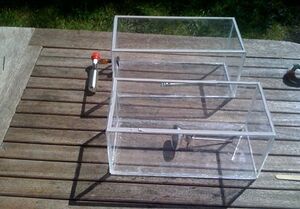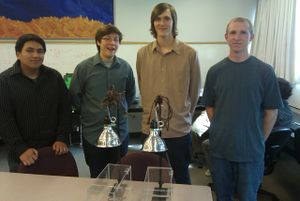
This webpage is about the Redwood Coast Energy Authority (RCEA) Educational Box project. The purpose of this project was to create an educational box with teaching material for high school teachers in Humboldt County. The teaching material provided is about the cause and effects of climate change.
Background[edit | edit source]
As stated by the EPA, climate change refers to any significant change in measures of climate such as temperature, precipitation, or wind lasting for an extended period, decades or longer. The Climate Connection incorporates a set of teaching materials. Included in the box is an introduction and conclusion PowerPoint, a Greenhouse effect experiment and a climate change game.
Climate Kit[edit | edit source]
This educational box will be used at least three times during the school year by teachers and students. We produced one box filled with educational material concerning climate change. Materials in the box will be maintained and replenished by the Redwood Coast Energy Authority (RCEA).
RCEA[edit | edit source]
The Redwood Coast Energy Authority (RCEA) is an in between nonprofit and profit organization to help inform the public of energy awareness around the North Coast of California, mainly Humboldt County. RCEA has spread knowledge of environmental awareness to the community and businesses in Humboldt County, including going to neighborhoods and replacing old light bulbs with energy efficient compact fluorescent light bulbs also known as CFLs. The RCEA also helps businesses with light retrofits providing information and installation of light fixtures that in time could reduce their energy expenses.
Problem Statement and Criteria[edit | edit source]
The objective of this design project is to build an educational kit/box that will be used by teachers to educate students on environmental and energy issues of the world. Working with our client, Oliver Hulland of the Redwood Coast Energy Authority (RCEA), the educational kit/box will be distributed and maintained for continual use in the local schools of Humboldt County.
Criteria[edit | edit source]
(listed from most important to least important)
- Educational Value: The display should offer a lot to teach high school students about climate change.
- Safety: All materials used should not be harmful to the students. If there are hazardous materials they must be handled by a teacher/supervisor.
- Durability: High school students will be handling the design. The design must be able to withstand a minimum of a year's worth of use.
- Level of Engagement: Display should keep the interest of high school students to the point where they learn efficiently.
- Ease of Use: The display should be simple enough for high school students to be able to use and understand without any difficulty.
- Cost: Maximum amount of $400 for the design project. $100 coming from the client and $75 from each group member.
- Age Appropriateness: The box should target high school students to be able to learn without any difficulties.
- Ease of Maintenance: The educational box should not have any complications when maintaining the upkeep of the items.
- Aesthetics: The educational box should be built with quality and pleasing to the eye for the students and the teachers.
- Transportability: The box should be easy to transport to and from the classroom by anyone including the teacher or an RCEA employee.
Description of Final Project[edit | edit source]
The final solution entitled The Climate Connection. This educational box is a three-part box that includes an informative section, a game and an experiment for the students. This layout can be used for multiple days in the classroom. The powerpoints will introduce the students to the topics of climate change on the first day. On the last day the student's will be given another PowerPoint that will tie in the experiment, the game, and more information on climate change together. The there is the Cap and Trade game to show the students the economic side of climate change. Last is the Model Greenhouse experiment which will show the students how greenhouse gases heat up the earths atmosphere.
PowerPoint[edit | edit source]
The first part of the final solution is an informative power point. The students will be introduced to the topics of climate change on the first day and on the last day the students will be given another PowerPoint that will tie in the experiment, the game and more information on climate change together. The PowerPoint's are brief, but educational having animations and information that will not bore the students, also included note cards for the teachers for more in depth information on the topics so the teachers can lecture the information as well. If the teacher does not want to lecture for the entire class period, a worksheet for the students will also be inside the box to give them incentive to pay attention and write down notes. The power points will include topics of greenhouse gases, the definition of climate change, causes and effects and as well as what the human race can do to help.
Cap and Trade Game[edit | edit source]
The second part of the box is a Cap and Trade game. In the box an excel sheet on a usb jump drive will be included that will have the lay out for the game. If the teacher does not have access to a digital projector, there will also be an instructional laminated sheet on how to draw the chart on the board if needed. The students will form groups of about 4-6 depending on the class size (5 students is ideal) and they will act as a big business company, buying and selling CO2 emissions. The point of this game is to show how economics can play a role in how much CO2 is emitted into the air. Certain groups will be portraying the role of bigger companies and they will be allowed more emissions to purchase. Students can also purchase technology so they can buy emissions at a lower rate in the later years. This game is trying to show a different side of climate change that many students have not heard about and hopefully open their eyes and keep them aware about the business of emission allowances.
Model Greenhouse Experiment[edit | edit source]
The third part of the final design box is a model greenhouse experiment, the box will include two clear boxes made of plexi-glass and glued by silicon about the size of a shoe box. Using a CO2 cartridge and a release valve, CO2 is injected into one of the boxes. The other box will be left alone and there will be thermometers inside each of the boxes to record the temperature increase. There will be heat lamps included which will be turned on pretending to be the sun and they will warm up the boxes, but because the first box has CO2 inside of it, it will rise in temperature at a much higher rate. The point of this experiment is to show that in a world with much more CO2 there is a much higher temperature amount than the one without or less of it. The students will use this experiment to record the temperature every 30 seconds or minutes for data and at the end of a certain time (10 minutes) they will use the data gathered and create a graph of time vs. temperature for each box and they will see a steady rise in temperature in the CO2 filled model greenhouse. A picture of the actual model can be seen in Figure 1.
Costs[edit | edit source]
The cost of implementation is the cost it took needed to build and create the three-part box. Figure 2 displays the amount needed to build and supply the products and materials for the box. The total combined cost for the final design cost $ 274.49.
| Materials | Quantity | Unit Cost($) | Overall Cost($) |
|---|---|---|---|
| Carbon Dioxide Release Valve | 1 | 20.00 | 20.00 |
| Carbon Dioxide Cartridge 16g | 3 | 1.99 | 5.97 |
| Carbon Dioxide Cartridge 12g | 25 | 0.74 | 38.99 |
| Clamp Lamp | 2 | 8.99 | 17.98 |
| Light Bulb | 1 | 0.98 | 0.98 |
| Caulk Lexel Glue | 1 | 5.49 | 5.49 |
| Weather Stripping | 1 | 2.59 | 2.59 |
| Acrylic Hinges | 5 | 1.95 | 9.75 |
| Metal Hinges | 4 | 3.79 | 15.16 |
| Acrylic Sheets (per square foot) | 9 | 5.50 | 49.50 |
| Latex Hose | 1 | 3.29 | 3.29 |
| Lamp Stand | 2 | 25.68 | 51.36 |
| Caulk Aquarium Silicon | 1 | 6.99 | 6.99 |
| Digital Thermometer | 2 | 12.99 | 25.98 |
| Total (Including Tax) | $274.49 |
Maintenance[edit | edit source]
The maintenance for the box should be relatively simple and inexpensive. The majority of maintenance to the box includes replacing CO2 cartridges and dead light bulbs. The CO2 cartridges and light bulbs can be purchased from a supplier whose information will be provided inside the box. Enough CO2 will be supplied initially to last about a year. After the CO2 has run out, new CO2 will have to be supplied by the RCEA. The model greenhouses should be kept clean for aesthetic purposes. Laminated copies of handouts for students will be provided inside the box. Copies will need to be made by the RCEA or the teacher using the box. The total cost of the box per year will be a maximum of 25 dollars.
Discussion and Next Steps[edit | edit source]
The RCEA will be loaning the box out to high school teachers in Humboldt County. RCEA will be storing the box and doing maintenance on it whenever something breaks or runs out.
Video[edit | edit source]
The Climate Crusaders[edit | edit source]

